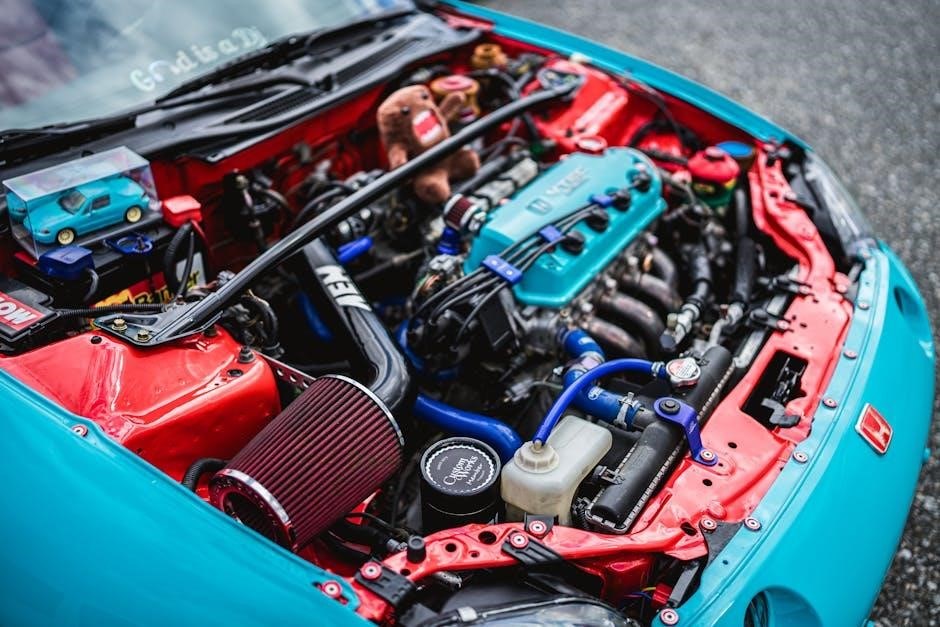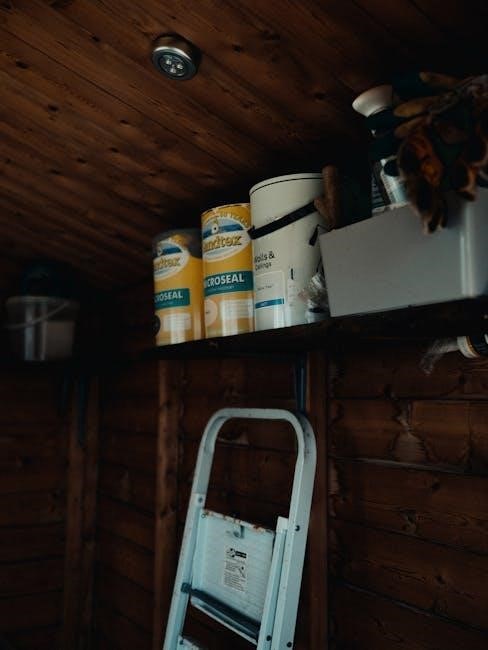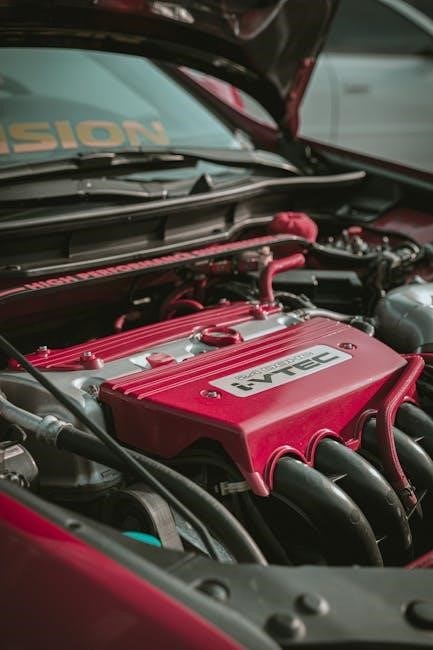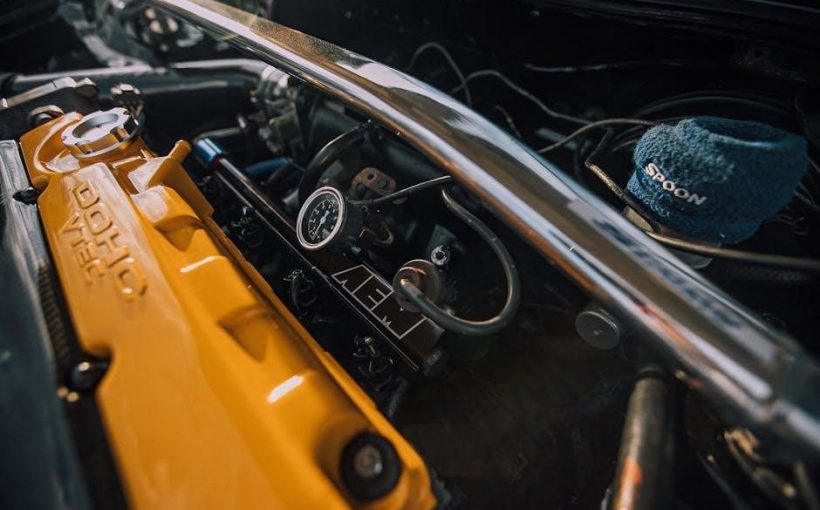The 2016 Honda CR-V maintenance schedule ensures optimal performance and longevity. Regular services like oil changes, tire rotations, and brake inspections are crucial. The Maintenance Minder system guides owners through recommended intervals, while detailed PDF guides provide comprehensive checklists for fluids, belts, and other components, ensuring reliability and safety on the road.
Overview of the 2016 Honda CR-V
The 2016 Honda CR-V is a compact SUV known for its reliability, versatility, and fuel efficiency. It features a 1.8L i-VTEC engine, offering smooth performance and excellent mileage. Available in both front-wheel and all-wheel drive, the CR-V caters to diverse driving needs. Its spacious interior, practical design, and advanced safety features make it a popular choice for families and commuters alike. The 2016 model also includes updates like enhanced infotainment systems and improved noise insulation, ensuring a comfortable and connected driving experience. With its robust build and modern technology, the CR-V remains a dependable vehicle for everyday use and long-distance travel.
Importance of Regular Maintenance
Regular maintenance is essential for preserving the performance, safety, and longevity of your 2016 Honda CR-V. Neglecting scheduled services can lead to premature wear, costly repairs, and reduced fuel efficiency. By following the recommended maintenance schedule, you ensure that critical systems like the engine, brakes, and tires function optimally. Regular checks also help identify potential issues early, preventing breakdowns and enhancing reliability. Additionally, consistent maintenance supports the vehicle’s resale value and ensures compliance with manufacturer warranties. Proper upkeep not only safeguards your investment but also guarantees a safer and more enjoyable driving experience for years to come.

Key Maintenance Services for the 2016 Honda CR-V
Essential services include oil and filter changes, tire rotations, and brake inspections. These ensure optimal performance, safety, and longevity, aligning with the recommended maintenance schedule.
Oil and Filter Changes

Regular oil and filter changes are vital for the 2016 Honda CR-V’s engine health. Honda recommends changing the oil every 5,000 to 7,500 miles, depending on driving conditions. Using the correct viscosity oil ensures optimal performance and fuel efficiency. The oil filter should also be replaced at each service to maintain proper engine lubrication. Neglecting these changes can lead to engine damage and reduced longevity. Always refer to the Maintenance Minder system for personalized service intervals. Proper oil maintenance is essential for keeping your CR-V running smoothly and preventing costly repairs down the road;
Tire Rotation and Pressure Checks
Regular tire rotation and pressure checks are essential for maintaining even tread wear and optimal performance in the 2016 Honda CR-V. Honda recommends rotating tires every 5,000 to 7,500 miles, following a specific pattern to ensure balanced wear. Proper tire pressure should be checked monthly, especially when tires are cold, to match the manufacturer’s specifications. Underinflated tires can lead to poor fuel efficiency and uneven wear. Neglecting these checks can result in reduced traction, compromised safety, and shorter tire lifespan. Always refer to the maintenance schedule for precise intervals and guidelines to keep your CR-V’s tires in top condition.
Brake System Inspection
The brake system inspection is a critical component of the 2016 Honda CR-V’s maintenance schedule. It ensures safety and performance by identifying potential issues early. Honda recommends inspecting brake pads, rotors, and fluid every 15,000 miles. Wear on pads and rotors can lead to reduced stopping power and increased risk of accidents. Additionally, brake fluid should be checked for contamination and level, and replaced as needed. Any signs of wear or damage should be addressed promptly by a certified technician to maintain reliable braking performance and ensure the vehicle’s safety features function as intended. Regular inspections prevent costly repairs and enhance overall safety.
Recommended Maintenance Schedule
The 2016 Honda CR-V maintenance schedule outlines services at 5,000-7,500 miles, 15,000 miles, and 30,000 miles. These intervals ensure optimal performance, prevent issues, and maintain reliability over time.
Every 5,000 to 7,500 Miles
At every 5,000 to 7,500 miles, the 2016 Honda CR-V requires essential maintenance to ensure smooth operation. This interval typically includes an oil and filter change, tire pressure checks, and a visual inspection of key components like brakes, belts, and hoses. Additionally, the Maintenance Minder system may prompt specific services based on actual driving conditions. It’s also a good time to inspect the wiper blades, air filter, and battery terminals for wear or corrosion. Following this schedule helps prevent potential issues and keeps the vehicle running efficiently. Regular checks at this interval are crucial for maintaining reliability and performance over time.
Every 15,000 Miles
At every 15,000 miles, the 2016 Honda CR-V requires more detailed maintenance to ensure continued performance and reliability. This interval includes all services from the 5,000 to 7,500-mile schedule, such as oil and filter changes, tire rotations, and brake inspections. Additionally, the air filter should be replaced, and the belts and hoses should be inspected for cracks or wear. The battery and charging system should also be tested to ensure proper function. Fluid levels, including coolant and transmission fluid, should be checked and topped off if necessary; This comprehensive check helps identify potential issues before they become major problems, ensuring your CR-V runs smoothly for years to come.
Every 30,000 Miles
At 30,000 miles, the 2016 Honda CR-V requires more extensive maintenance to address wear and tear. This includes replacing the spark plugs to ensure proper engine performance and fuel efficiency. The belts and hoses should be inspected for signs of deterioration and replaced if necessary. Additionally, the PCV valve should be cleaned or replaced to maintain proper emissions and engine operation. The exhaust system should also be inspected for leaks or damage. These services help prevent major repairs and ensure the vehicle continues to run efficiently. Following this schedule is crucial for maintaining the longevity and reliability of your CR-V.

Inspecting and Maintaining Vehicle Systems
Regular inspections of wiper blades, tires, and battery ensure optimal performance. Replace wiper blades every 6-12 months for clear visibility. Check tire tread and pressure monthly, and test battery health annually to avoid unexpected issues.

Wiper Blades
Regular inspection and replacement of wiper blades are essential for maintaining clear visibility while driving. The 2016 Honda CR-V maintenance schedule recommends checking wiper blades every 6 to 12 months. Look for signs of wear, such as cracked rubber, uneven wiping, or streaks on the windshield. Replace blades immediately if damage is detected. Properly functioning wipers are crucial for safety, especially during rain or snow. Always use genuine Honda replacement blades for optimal performance and ensure they are installed correctly to maintain your CR-V’s reliability and your safety on the road.
Tires
Regular tire maintenance is critical for safety and performance. The 2016 Honda CR-V maintenance schedule recommends rotating tires every 5,000 to 7,500 miles to ensure even wear; Check tire pressure monthly, including the spare, and before long trips. The recommended pressure is typically 35 PSI for most models. Inspect tires for signs of wear, such as uneven tread or cracks, and replace them if necessary. Properly maintained tires improve fuel efficiency, handling, and braking performance. Always refer to the owner’s manual or maintenance schedule for specific guidelines tailored to your vehicle.

Battery
Regular battery maintenance is essential for reliable starting and electrical system performance. The 2016 Honda CR-V maintenance schedule recommends inspecting the battery terminals and cables for corrosion or damage. Ensure the battery hold-down is secure and check the electrolyte level if applicable. Charging and testing the battery are advised, especially in extreme temperatures. Proper maintenance prevents unexpected starting issues and ensures consistent power delivery to vehicle systems. Always follow the guidelines in the owner’s manual or maintenance schedule for specific instructions tailored to your CR-V.

Fluid Checks and Replacements
Regular fluid checks and replacements are vital for the 2016 Honda CR-V’s performance. Engine oil, coolant, and transmission fluid levels should be inspected and topped off as needed. Replacements are scheduled at specific intervals to ensure optimal lubrication and cooling, preventing overheating and engine damage. Always refer to the maintenance schedule for recommended intervals and guidelines to maintain your CR-V’s health and longevity.
Engine Oil
Engine oil is essential for lubricating and protecting the 2016 Honda CR-V’s engine. Regular oil changes are recommended every 5,000 to 7,500 miles, depending on driving conditions. Use 0W-20 viscosity oil for optimal performance. The Maintenance Minder system will alert you when an oil change is due. Always check for leaks during oil changes and ensure the oil level is within the recommended range. Proper engine oil maintenance prevents overheating, reduces wear on moving parts, and extends the lifespan of your vehicle. Refer to the schedule for specific guidelines and intervals to keep your CR-V running smoothly.
Coolant
Coolant plays a critical role in maintaining the 2016 Honda CR-V’s engine temperature. It should be checked at every 15,000-mile service interval and replaced as recommended, typically around 30,000 miles. Use a 50/50 mix of Honda-approved coolant and water to ensure proper performance. Inspect the coolant level, color, and condition regularly. Low levels or signs of leakage require immediate attention to prevent overheating. The radiator and hoses should also be examined for cracks or damage. Proper coolant maintenance ensures efficient engine cooling, prevents corrosion, and avoids costly repairs. Always refer to the maintenance schedule for precise guidelines on coolant care.
Transmission Fluid
Transmission fluid in the 2016 Honda CR-V should be checked every 15,000 to 30,000 miles to ensure smooth gear operation. Use Honda ATF DW-1 for optimal performance. Signs of dirty or low fluid include slipping gears or delayed shifting, requiring immediate attention. The fluid level is typically checked with the engine warm and parked on a level surface. If fluid replacement is needed, it’s usually recommended around 60,000 miles or as indicated by the Maintenance Minder. Regular transmission fluid maintenance prevents wear, extends component life, and ensures reliable transmission performance, avoiding costly repairs down the road.

Additional Maintenance Tips
Regularly check and replace the air filter every 15,000 miles to improve fuel efficiency and performance. Inspect belts and hoses annually or at 60,000 miles for signs of wear. Ensure all fluids, including coolant and transmission fluid, are at recommended levels to prevent overheating and mechanical damage. These simple steps enhance reliability, reduce repair costs, and keep your CR-V running smoothly for years.
Air Filter Replacement
The 2016 Honda CR-V recommends replacing the air filter every 15,000 miles to ensure optimal engine performance and fuel efficiency. Located under the hood, the air filter should be inspected during regular maintenance. A dirty or clogged filter can reduce airflow, leading to decreased performance and lower MPG. Refer to the maintenance schedule PDF for precise instructions. Use genuine Honda parts for the best results. Proper replacement involves opening the air filter housing, removing the old filter, and installing a new one. This simple process helps maintain your CR-V’s efficiency and prevents potential engine damage from dust and debris.
Belts and Hoses Inspection
The 2016 Honda CR-V maintenance schedule recommends inspecting the serpentine belt every 15,000 miles and replacing it at 105,000 miles. Signs of wear, such as cracks or fraying, indicate the need for replacement. Hoses, including coolant and power steering hoses, should also be checked for cracks, leaks, or soft spots. Regular inspections prevent sudden failures, which can cause engine damage or breakdowns. While the CR-V is known for reliability, neglecting belt and hose maintenance can lead to costly repairs. Always refer to the maintenance schedule PDF for precise intervals and guidelines to ensure your vehicle runs smoothly and safely. A professional technician can perform these checks efficiently.

Diagnostic Tools and Maintenance Minder
The 2016 Honda CR-V features the Maintenance Minder system, which alerts drivers when routine maintenance is due. Diagnostic tools help monitor vehicle health and ensure timely service.

Understanding the Maintenance Minder System
The Maintenance Minder system in the 2016 Honda CR-V is a sophisticated tool designed to notify drivers when routine maintenance is required. It calculates service needs based on mileage, driving conditions, and time. The system provides specific codes that indicate the type of maintenance needed, such as oil changes or tire rotations. This feature ensures that owners stay on track with recommended services, preventing potential issues and extending the vehicle’s lifespan. By following the Maintenance Minder’s alerts, CR-V owners can maintain optimal performance, reliability, and safety on the road.
Using Diagnostic Tools for Routine Checks
Diagnostic tools play a key role in maintaining the 2016 Honda CR-V. The Maintenance Minder system provides codes to guide routine checks, ensuring timely service. Owners can use scan tools or consult the owner’s manual to interpret these codes, which highlight specific maintenance needs. Additionally, the vehicle’s onboard diagnostics monitor vital systems, offering real-time insights. Regular use of these tools helps identify potential issues early, preventing costly repairs. By leveraging diagnostic capabilities, CR-V owners can ensure their vehicle runs efficiently, adhering to the recommended maintenance schedule for optimal performance and longevity.
Adhering to the 2016 Honda CR-V maintenance schedule ensures reliability and optimal performance. Regular checks and timely services extend the vehicle’s lifespan, enhancing safety and efficiency.
Importance of Adhering to the Schedule
Adhering to the 2016 Honda CR-V maintenance schedule is essential for preserving its performance, reliability, and longevity. Regular maintenance prevents potential issues, enhances fuel efficiency, and ensures safety. By following the recommended intervals, owners can avoid costly repairs and unexpected breakdowns. Proper upkeep also maintains the vehicle’s value and provides peace of mind. The Maintenance Minder system offers personalized reminders, making it easier to stay on track. Consistency in maintenance ensures all systems function optimally, reducing wear and tear. Over time, this commitment to routine care translates into a smoother, safer, and more enjoyable driving experience.
Long-Term Benefits of Proper Maintenance
Proper maintenance of the 2016 Honda CR-V ensures long-term reliability and performance. Regular care extends the vehicle’s lifespan, prevents major repairs, and maintains its value. By following the schedule, owners can enjoy consistent performance, improved fuel efficiency, and reduced operational costs. Properly maintained vehicles also experience fewer mechanical issues over time, providing peace of mind. Additionally, a well-maintained CR-V retains higher resale value, making it a smarter investment. The combination of routine inspections, timely repairs, and adherence to the Maintenance Minder system ensures the vehicle runs efficiently for years, delivering a safe and enjoyable driving experience.
